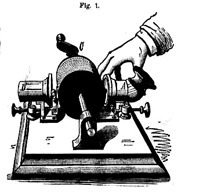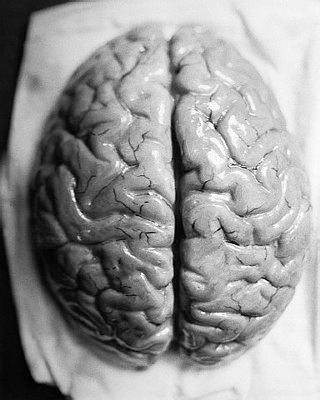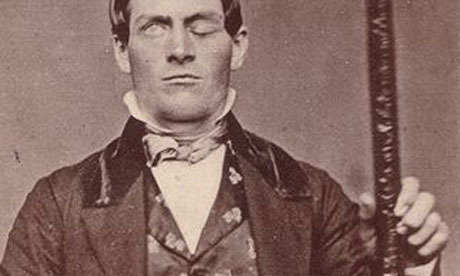Derren Brown's Blog, page 62
November 15, 2010
Voices of the dead – The Last Tuesday Society

Inventor and crackpot musician Sarah Angliss will be giving a performance that will include the strange, mysterious and bizarre attitudes to early sampling technology:
In December 1877, a journalist writing in Scientific American noted there was a now 'a startling possibility of recording voices of the dead'. He had just witnessed Edison recording sound on his new invention: the phonograph.
In this live demonstration, I'll explore some of the stranger obsessions of the early adopters of audio recording, as I immortalise a voice from the audience by recording it on wax, using an original Edison Standard Phonograph.
Delving into the archives, I'll also examine a little-known curiosity from the eighteenth century, one which may have been used to record short segments of sound 150 years before the phonograph.
This event will include some short, musical interludes incorporating a few of my own inventions. As I use the theremin to conjure up 'music from the aether', I'll reveal how the first 'electric servants' were also seen as tools for paranormal investigation.
10 December 2010
The Last Tuesday Society
11 Mare Street
London E8 8RP
Tickets £4-£12
Full details of this performance (which by the way a few of the web team will be attending) here.
Tetris flashback reduction effect 'special'

"The computer game Tetris may have a special ability to reduce flashbacks after viewing traumatic images not shared by other types of computer game, Oxford University scientists have discovered in a series of experiments.
In earlier laboratory work the Oxford team showed that playing Tetris after traumatic events could reduce memory flashbacks in healthy volunteers. These are a laboratory model of the types of intrusive memories associated with post-traumatic stress disorder (PTSD).
In this new experimental study the researchers compared the effectiveness of Tetris at reducing flashbacks with Pub Quiz Machine 2008, a word-based quiz game. They found that whilst playing Tetris after viewing traumatic images reduced flashbacks by contrast playing Pub Quiz increased the frequency of flashbacks.
A report of the research is published in this week's edition of the journal PLoS ONE."
Read more at The University of Oxford (Thanks Katherine R)
Ears Could Make Better Unique IDs Than Fingerprints

"On a planet hosting 6.7 billion human beings, having proof you're unique is of tantamount importance. The ear, it turns out, may be the best identification yet.
Through a new shape-finding algorithm called "image ray transform," which boasts 99.6 percent accuracy, according to a study presented at the IEEE Fourth International Conference on Biometrics Sept. 29, the outer ear may prove to be one of the most accurate and least intrusive ways to identify people.
Fingerprint databases of U.S. government agencies alone store the records of more than 100 million people, but prints can rub off or callous over during hard or repetitive labor. With the advent of computer vision, researchers and identification industries are seeking easier and more robust biometrics to get their hands on.
"When you're born your ear is fully formed. The lobe descends a little, but overall it stays the same. It's a great way to identify people," said Mark Nixon, a computer scientist at the University of Southampton. and leader of the research.
"There's real power in using the appearance of an ear for computer recognition, compared to facial recognition. It's roughly equivalent if not better," said computer scientist Kevin Bowyer of Notre Dame, who is pursuing his own ear-recognition technology and not involved with Nixon's work. "If you've got a profile image for someone, this is a great way to use it.""
Read more at Wired (Thanks Johnny5)
How fear flows through the mind
"A neuronal circuit in the brain acts like a seesaw to control fear impulses, reveals a surprisingly up-close look at neurons. Researchers have identified two neuron populations in the brain that work together to control fear impulses.
The findings, published this week in a pair of complementary papers in Nature, may someday facilitate the development of better therapeutic interventions for psychiatric illnesses such as post-traumatic stress disorder and phobias.
"A real exciting aspect of this work is how we've now come to understand the regulation of complex emotion — in this case fear — at a single cell level," said Stephen Maren, director of the Neuroscience Graduate Program at the University of Michigan, who was not involved in the research. "That's a pretty impressive feat."
The amygdala, an almond-shaped structure in the brain involved in emotional memory and learning, has historically been considered key in processing fear impulses, but researchers at the California Institute of Technology wanted to understand the process at the level of cells. "Ultimately, we'd like a mechanistic understanding of how specific circuits, not only regions, generate brain functions like fear," said Wulf Haubensak, a postdoc and first author on the first paper.
After conducting systematic screens for genes marking neurons in the amygdala, the team focused on one — a gene encoding protein kinase C delta, or PKC-δ, which was specifically expressed in a subpopulation of neurons that had not been studied in detail. "We decided to try and find out what these cells do," said David Anderson, a biologist and senior author on the paper. "
Read more at The Scientist (Thanks Johnny5)
November 14, 2010
Heads-up on a few things probably coming out
Subject to all sorts of possible changes, the following goodies (or baddies, really depends) are planned: the 'Enigma' show should be broadcast (in it's 3-hours-squeezed-into-one-and-a-half form) around mid-December, and hopefully in early January, a documentary about my good self will air for those who enjoy such things, alongside a broadcast of the most-voted-for-fave-special (you can vote, I am assured, here). My oldest pal from school (now a multi-award-winning filmmaker) was approached, quite by coincidence, to make the documentary, and it's deepened our friendship and been a real joy exploring some nostalgic avenues together.
Also, in January, I'm quite excited that they're planning to release a box-set of the stage shows (at least the ones that made it to TV). So Something Wicked, And Evening of Wonders, and Enigma will be all nicely packaged up for your DVD delectation. Imagine! What larks.
As you may know, I'm writing the new stage show, Svengali: the long and short of it is that we rehearse next January/Feb for the tour that starts in March. And somewhere in there we hope to film a new special, though when that will make the screens I have no idea.
Um, that's it for now. Today I'm drinking tea and painting Patrick Hughes and I'll show you that and the little story around it when it's done.
Ta-ta,
D
Added by Abeo:
The Enigma DVD is available for Pre-order here (click here)
The Derren Brown Live Collection DVD is available for Pre-order here (click here)
RSA videos
Some terrific animated lectures by RSA on YouTube – I've been quite captivated all morning.
Nov. 12, 1935: You Should (Not) Have a Lobotomy

"1935: The world's first modern frontal leukotomy is performed in a Lisbon hospital by Portuguese neurologist Antonio Egas Moniz.
Moniz's leukotomy (or leucotomy, from the Greek for "cutting white," in this case the brain's white matter) soon became popularly known as the lobotomy. It was not, however, the surgical procedure now generally associated with lobotomies. Rather, Moniz drilled two holes in the patient's skull and injected pure alcohol into the frontal lobes of the brain to destroy the tissue, in an effort to alter the patient's behavior.
Within a year of Moniz's procedure at Lisbon's Santa Marta Hospital, American neurosurgeons Walter Freeman and James Watts had performed the first prefrontal lobotomy in the United States. Their approach, which they would continue refining in subsequent surgeries, also involved drilling holes, but instead of using alcohol they surgically severed the nerves connecting the prefrontal cortex to the thalamus.
With various refinements, this became standard operating procedure for the prefrontal lobotomy.
Lobotomies were performed on patients suffering from severe mental disorders such as schizophrenia and clinical depression, although its use on people identified as having social disorders was not unknown. That the lobotomy succeeded in altering a person's personality and behavior is beyond dispute, but the results were often drastic, and occasionally fatal."
Read more at Wired
Sugar cube-sized supercomputer in 10 to 15 years: IBM
"IBM scientists have said that a pioneering research effort could shrink the world's most powerful supercomputer processors to the size of a sugar cube.
The approach will see many computer processors stacked on top of one another, cooling them with water flowing between each one.
The plan is to reduce computers" energy use, rather than just to shrink them.
Dr Bruno Michel said future computer costs would hinge on green credentials rather than speed.
Michel and his colleagues have already built a prototype to demonstrate the water-cooling principle. Called Aquasar, it occupies a rack larger than a refrigerator.
IBM estimates that Aquasar is almost 50 pc more energy-efficient than the world"s leading supercomputers.
"In the past, computers were dominated by hardware costs – 50 years ago you could hold one transistor and it cost a dollar, or a franc," the BBC quoted Michel as saying at IBM"s Zurich labs.
Now when the sums are done, he said, the cost of a transistor works out to 1/100th of the price of printing a single letter on a page.
The overwhelming cause of those energy costs is in cooling, because computing power generates heat as a side product.
The Aquasar prototype clocked up nearly half again as much, at 1.1 billion operations. Now the task is to shrink it.
"We currently have built this Aquasar system that's one rack full of processors. We plan that 10 to 15 years from now, we can collapse such a system in to one sugar cube – we're going to have a supercomputer in a sugar cube.""
Read more at BioScholar
Eggs with the oldest known embryos of a dinosaur found

"Palaeontologists have identified the oldest known dinosaur embryos, belonging to a species that lived some 190 million years ago. The eggs of Massospondylus, containing well-perserved embryos, were unearthed in South Africa back in 1976. The creature appears to be an ancestor of the family that includes the long-necked dino once known as Brontosaurus.
The study in the Journal of Vertebrate Paleontology also sheds light on the dinosaurs' early development. The researchers used the embryos to reconstruct what the dinosaurs' babies might have looked like when they roamed the Earth. Having studied the fossilised eggs, the team, led by Professor Robert Reisz of the University of Toronto Mississauga in Canada, discovered that the embryos were the oldest ones ever found of any land-dwelling vertebrate.
"This project opens an exciting window into the early history and evolution of dinosaurs," said Professor Reisz. "Prosauropods are the first dinosaurs to diversify extensively, and they quickly became the most widely spread group, so their biology is particularly interesting as they represent in many ways the dawn of the age of dinosaurs.""
Read more at BBC News
November 13, 2010
Phineas Gage and the effect of an iron bar through the head on personality

"The photograph above, which was uncovered earlier this year, is one of only two known images of an otherwise unremarkable man named Phineas Gage who attained near-legendary status in the history of neuroscience and psychology one fateful day in 1848 at the age of 25.
Gage earned his place in the neurological hall of fame in a most unusual – and extremely unfortunate – way. A railroad construction foreman in the US, he was in charge of a crew of men who were working on the construction of the Rutland and Burlington Railroad near Cavendish, Vermont. On 18 September, he and his crew were excavating rocks to make way for the railroad. Gage was preparing for an explosion, using the tamping iron he holds in the photograph to compact explosive charge in a borehole. As he was doing so, the iron produced a spark that ignited the powder, and the resulting blast propelled the tamping iron straight through his head.
John Harlow, the physician who attended to Gage at the scene, noted that the tamping iron was found some 10 metres away, "where it was afterward picked up by his men, smeared with blood and brain". He provides a detailed description of the "hitherto unparalleled case" in a letter to the editor of the Boston Medical and Surgical Journal, entitled "Passage of an Iron Rod Through the Head":
"[The tamping iron] entered the cranium, passing through the anterior left lobe of the cerebrum, and made its exit in the medial line, at the junction of the coronal and sagittal sutures, lacerating the longitudinal sinus, fracturing the parietal and frontal bones extensively, breaking up considerable portions of the brain, and protruding the globe of the left eye from its socket, by nearly half its diameter. "
Remarkably, Gage survived this horrific ordeal, and by all accounts was conscious and walking within minutes. Back at Gage's nearby lodgings, Harlow removed small bone fragments from the wounds, replaced larger fragments that had been displaced by the passage of the tamping iron, and closed the large wound at the top of Gage's head with adhesive straps.
Several days later, one of the wounds became infected and he fell into a semi-comatose state. Fearing the worst, his family prepared a coffin, but Gage soon recovered and by January 1849 was leading an apparently normal life. But those closest to him began to notice dramatic changes in his behaviour."
Read more at The Guardian (Thanks @XxLadyClaireXx)
Derren Brown's Blog
- Derren Brown's profile
- 797 followers



